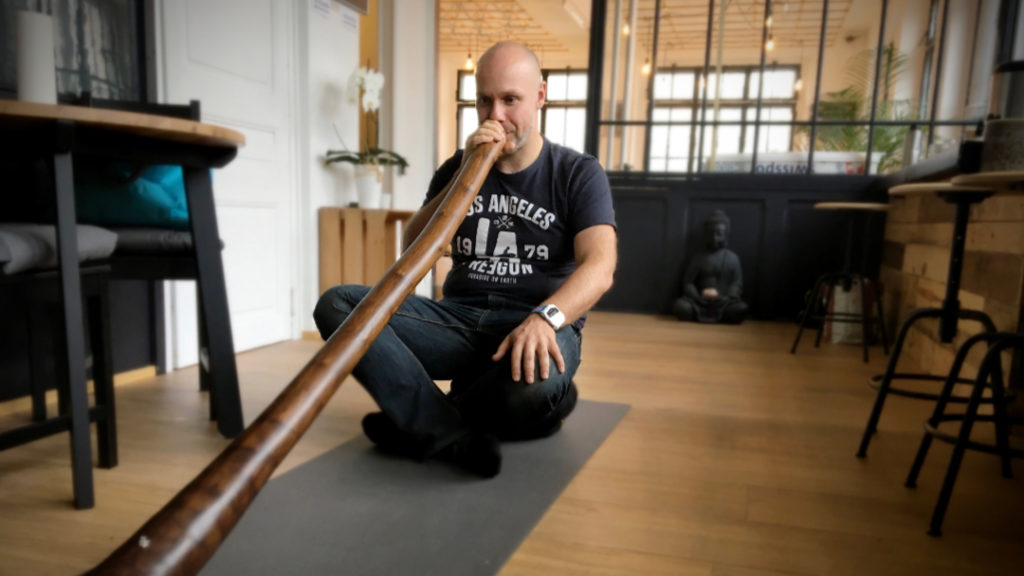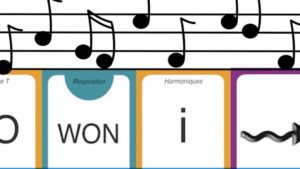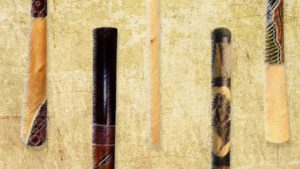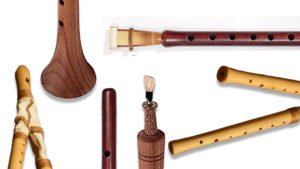Aaaaah, circular breathing! This legendary and mysterious technique! A quick reminder on what this is: circular breathing allows musicians to play continuously without having to stop to get some air. Enabling such ability, this breathing technique is intriguing! Moreover, didgeridoo players know this well and after you announce blowing in a didgeridoo, the following question is inevitably: “Oh yes? And can circular breath?!?!?! ». So get ready, dear neophyte friends and connoisseurs, because it is time to unveil the veil on obscure mechanisms only known by the initiated, until now (if you want to learn circular breathing go here: 6 free videos to master circular breathing!)!
What is circular breathing
The question that everyone asks themselves is: “How can we breathe in while breathing out at the same time? That’s impossible! ». Don’t worry, yes, it simply is impossible.
The way circular breathing works is identical to that of the bagpipe except that the air supply is not outside the body, but in one’s oral cavity (where the largest volume is obtained when inflating one’s cheeks). The musician will have to use a reserve of air to continue the drone during inspiration. It is then enough to push the air contained in the mouth to inhale through the nose at the same time. And it is precisely this synchronization phase that often poses the most difficulties for beginners.
Understanding the mechanism of circular breathing
During the breathing in phase, the musician must continue to expel air to maintain the drone (or the sound of the wind instrument). There are two main ways to push the air outside and thus maintain an uninterrupted stream of air:
-
Using cheeks
This is the best-known technique (but certainly the least played! Because most of the time it’s mix with some others breathing techniques). In this case, the air will be pushed out by squeezing the cheeks.
-
Using the tongue
This method is more confidential than cheeks, because our tongue works in the shadows. Moreover, we are rarely aware of our movements. However, most of the time, it is the tongue that plays the greatest role in circular breathing! I’ll explain it to you right after. Will the tongue finally shine in front of cheek dictation? Only time will tell!
Let’s take a closer look at the movement of the circular breathing
So, what happens inside the mouth during the whole process?
- The player needs to breathe in. This means he is going to have to isolate an air supply from his lungs. To do this, the bottom of the tongue is pressed against the soft palate. (see video below at the beginning of the WO)
- Then the inspiration takes place. The air enters through the nose and goes to the lungs. The player then expels the air at the same time as the air supply contained in his mouth.
Didgeridoo under MRI to better visualize the circular breathing
Here is a video of Rodrigo Viterbo who played in an MRI. We can observe, at the moment of the WO (which symbolizes the moment when it inspires) that the bottom of his tongue is being placed on the soft palate. Then, the bottom of his tonguegoes forward to drive the air out of the mouth.
Rodrigo Viterbo playing didgeridoo in an MRI. Discover the experience on his
website.
If you look at it more closely, you realize that the player has several choices to perform circular breathing. He will therefore be able to choose between:
- his cheeks, they offer the greatest air capacity. They will therefore leave the possibility of making a longer sound for a greater inspiration.
- The middle of his tongue, with a limited volume of air and therefore a shorter inhalation, the rhythm should be quite fast or there will be a small cut in the sound
- his language background , with a small volume of air and therefore a shorter breath, the rhythm must be fast enough otherwise the sound will cut off.
- And finally his tip of the tongue, the latter is only usable for fast playing because of the very small amount of air to be expelled…
The goal of the didgeridoo is to seek the maximum independence between these different options.
It will then be possible to mix all these techniques, just like the painter who mixes the primary colors to form an infinite number of combinations. Of course, the entire process is linked, and each technique cannot be 100% independent. That being said, this should not prevent us from pushing our limits! For those of you who have noticed the absence of the jaw, this is intended, because it “only helps” the tongue.
The big mistake about the topic of circular breathing!
There is therefore a real confusion between the role of the cheeks and the tongue. To better understand how this misunderstanding has spread, let’s take for example this video by Kenny G explaining the circular breathing technique adapted to the saxophone.
We can see very clearly that his cheeks inflate very little. They do move slightly (very slightly), but it is his tongue that does most of the work. Cheeks are only accessories. And yet, he explains to us how to push the air with his cheeks! As I write this article, this video has been viewed 592,536 times! We quickly understand how the misunderstanding between cheek and tongue could have been self-sustaining!
Of course, I have nothing against Kenny G. This video is just a random example. There are many others on the Internet.
To each didgeridoo rhythm its circular breathing!
It soon becomes clear that, depending on the rhythms played, it will be necessary to use such and such techniques. And here lies the real difficulty of circular breathing! Indeed, a player will quickly get into the habit of using only one of the above-mentioned techniques. However, playing didgeridoo with only one circular breathing technique will greatly limit the rhythms and possibilities of variation. Because a bottom tongue will always be played slowly overall. On the other hand, a tongue tip will lock the player into producing short sounds and therefore playing fast rhythms or risking having a chopped game.
Determined to learn circular breathing!
For the record, I remember very well the moment I understood the mechanism of circular breathing. It was a few weeks after I started playing didgeridoo. One night, I was lying in my bed ready to sleep. I was trying to follow an exercise that I had been told to do without a didgeridoo to understand circular breathing.
I thought to myself, “Okay Gauthier, you won’t sleep until you understand this. ». After a few hours of training, I had managed to inhale through my nose while emptying my cheeks… I understood and the sun had just risen. Certainly one of my most beautiful sleepless nights!
Conclusion: The circular breathing is complex but accessible
You have seen it when you dig a little deeper, learning and mastering circular breathing in all its forms takes years. But believe me (or don’t!), the basic technique is actually quite accessible, and rapidly. With good exercises and a previously stabilized sound, most of my students understand the mechanism in 2 or 3 classes no more (see also: 6 free videos to master circular breathing!).
Then what remains is smoothening and getting used to the technique, which comes with practice. Forget about those who tell you that it takes months and months: they didn’t have the right exercises or didn’t practice regularly! Any musician blowing into an instrument can acquire circular breathing very quickly and thus expand to new horizons. And if you are didgeridoo players, I can only encourage you to discover and tame the different techniques of circular breathing!
If you have learned anything in this article, the best way to thank me is to share it or leave a comment. You have no idea how encouraging that is!












